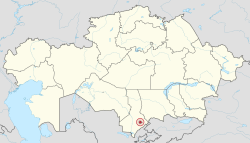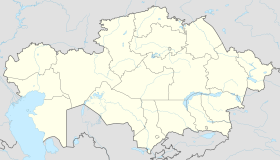
Back Sjimkent Afrikaans شيمكنت Arabic شيمكنت ARZ Çimkənd Azerbaijani Шымкент Bashkir Шымкент Byelorussian Шымкент BE-X-OLD Шъмкент Bulgarian Šimkent BS Ximkent Catalan
Shymkent
Şymkent Шымкент | |
|---|---|
|
From top left to down right: Tulip fountain, Russian Drama Theater, Altyn Shanyraq Monument, pedestrian street Arbat at Night, Ordabassy Square at Night, Old Citadel. | |
 | |
| Coordinates: 42°19′0″N 69°35′45″E / 42.31667°N 69.59583°E | |
| Country | Kazakhstan |
| Founded | 3rd-2nd century BC |
| Government | |
| • Body | City Mäslihat |
| • Akim | Gabit Syzdykbekov[2] |
| Area | |
• Total | 1,170 km2 (450 sq mi) |
| Elevation | 506 m (1,660 ft) |
| Population (1 June 2024) | |
• Total | 1,236,900[1] |
| Time zone | UTC+5 (UTC+5) |
| Postal code | 160000 |
| Area code | (+7) 7252 |
| ISO 3166 code | SHY |
| Vehicle registration | 17 |
| HDI (2019) | 0.795[3] very high · 6 |
| Climate | Dsa / Csa |
| GDP (nominal) | 2022 |
| • Total | (KZT 3 294 392,3 million )[4] |
| • Per capita | (KZT 2 798 thousand) |
| Website | shymkent |
Shymkent (Kazakh: Шымкент, Şymkent; pronounced [ʃɯmˈkʲent] ⓘ) is a city in southern Kazakhstan, located near the border with Uzbekistan. It holds the status of a city of republican significance, one of only three cities in Kazakhstan with this distinction, alongside Almaty and Astana. As of June 2018, Shymkent had an estimated population of 1,002,291, making it the third-most populous city in the country, after Almaty and Astana.[5]
Shymkent serves as a regional cultural and economic center. It is situated approximately 690 kilometers (430 miles) west of Almaty and 1,483 kilometers (920 miles) south of Astana, with a strategic location 120 kilometers (75 miles) to the north of Tashkent, Uzbekistan. Its proximity to Uzbekistan contributes to its importance as a trade and cultural hub in the region. The city is connected by Shymkent International Airport serving as a key gateway for domestic and international flights. The city is also a major railway hub, with Shymkent railway station providing connections to other major cities in Kazakhstan and neighboring countries. The city's transport network is complemented by an extensive bus system and road infrastructure, ensuring easy movement within the city and to surrounding regions.
The city has a rich history, with roots dating back to ancient times. Historically, Shymkent was part of the Silk Road, playing a crucial role in regional trade and cultural exchange. Today, it is known for its vibrant local culture, historical sites, and growing economy, driven by industries such as manufacturing, agriculture, and trade.
Shymkent's economy has been expanding in recent years, with infrastructure improvements and a focus on modernizing its urban landscape. It is home to several universities and cultural institutions, making it an educational hub in the region. The city's diverse population, which includes Kazakhs, Uzbeks, and other ethnic groups, reflects its historical role as a crossroads of cultures.
- ^ "Shymkent city - Statistics of the regions of the Republic of Kazakhstan - Agency for Strategic planning and reforms of the Republic of Kazakhstan Bureau of National statistics". www.stat.gov.kz.
- ^ "Gabit Syzdykbekov appointed as Shymkent Mayor". www.inform.kz. 5 September 2023.
- ^ "Sub-national HDI – Area Database – Global Data Lab". hdi.globaldatalab.org. Archived from the original on 23 September 2018. Retrieved 21 July 2021.
- ^ DOSM. "Department of Statistics Kazakhstan". stat.gov.kz. Archived from the original on 2 January 2024. Retrieved 1 August 2022.
- ^ "Об изменении численности населения Республики Казахстан с начала 2018 года до 1 июня 2018 года". stat.gov.kz. Retrieved 26 September 2021.







